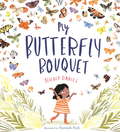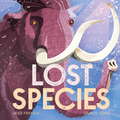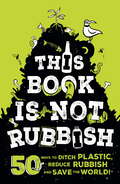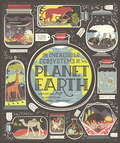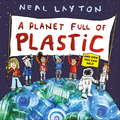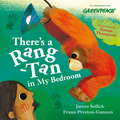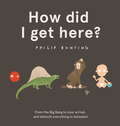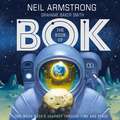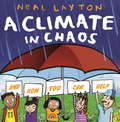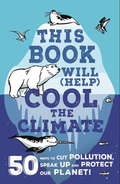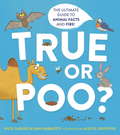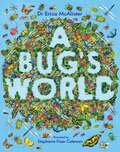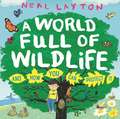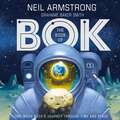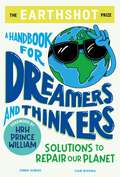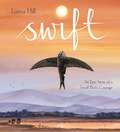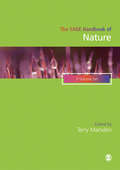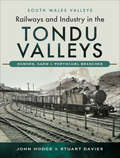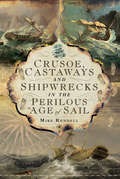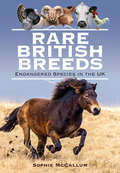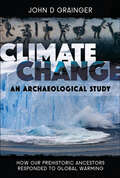- Table View
- List View
My Butterfly Bouquet
by Nicola DaviesWith breathtaking illustrations and a touching story, this dazzling picture book introduces young readers to one of nature's most magnificent and essential insects: the butterfly.See how a little girl recovering from poor health finds wonder in nature and delights in planting a garden with her father to attract a fascinating array of butterflies. Exploring the life stages of butterflies, their importance to our ecosystems and the revitalising power of nature, this book is a heart-warming information story for children who love the outdoors and all its incredible creatures.At the back of the book, discover tips on how to create your own wildlife garden to attract betterflies!
Lost Species
by Jess FrenchStep into an incredible lost world and marvel at the strange and magnificent creatures that once roamed our Earth. From the awe-inspiring woolly mammoth and the ferocious Spinosaurus to the shy Chinese river dolphin and incredibly rare Pinta Island tortoise 'Lonesome George', meet 35 extinct species and discover how these creatures came under threat. Featuring additional information on 'Lazarus species' (animals declared extinct but which, amazingly, have been rediscovered in the wild), and mass extinction events, including the part we are playing in endangering our wildlife, the book shows young readers that extinction is not simply a part of ancient history - it is happening right now across the planet - but that if we all make some small changes to our lifestyles, our wonderful species can be saved. With beautiful and vibrant illustrations throughout, this stunning large format compendium is a reminder of the remarkable animals we have lost, as well as a celebration of those that have returned from the brink of extinction.
This Book is Not Rubbish: 50 Ways to Ditch Plastic, Reduce Rubbish and Save the World!
by Isabel ThomasDiscover how YOU can ditch plastic, reduce rubbish and become an eco-warrior, not an eco-worrier, with 50 practical tips to really make a difference! Our planet is in peril and it needs your help! But the good news is that there are loads of easy ways that you can make a difference. From throwing a planet party and ditching straws, to banning glitter and becoming an art-activist, helping to save the planet is not as difficult as you think. Covering issues like plastics, pollution, global warming and endangered animals, this book is full of top tips for kids and families. Discover how to ditch the plastic, reduce your rubbish and start making everyday steps that will make all the difference. It's time to take control of your future and help clear the world of all this rubbish!
The Incredible Ecosystems of Planet Earth
by Rachel IgnotofskyAn illustrated tour of our planet's ecosystems both large and small, from reefs, deserts and rainforests to a single drop of water - from the bestselling author of Women in Science. Through exquisite illustrations, maps and infographics, bestselling author Rachel Ignotofsky explains how our planet works, from its incredible ecosystems and the plants and animals that live there to the importance of biodiversity, weather cycles and more. Including information on the dangers of climate change and ideas for how to protect Planet Earth, this utterly charming guide is the perfect gift for all nature-loving readers on the planet we call home.
A Planet Full of Plastic: and how you can help
by Neal LaytonEverything is made of stuff. Some things are made of paper, like this book. And some things are made of PLASTIC. If you look around you, plastic is everywhere. Even in places where it's not meant to be. If it drops to the ground, it doesn't rot away - it sticks around for ever.Our world is drowning in plastic, and it's a big problem. Award-winning author-illustrator Neal Layton is here to explain where plastic comes from, why it doesn't biodegrade, and why that's dangerous for animals and humans alike. But he's also FULL of ideas for how you can help! From giving up straws in juice cartons to recycling all we can and taking part in a beach clean, A Planet Full of Plastic will get young readers excited about how they can make a difference to keep Planet Earth happy.This brilliant non-fiction picture book, illustrated in Neal's trademark collage style, is perfect for readers aged 5-7 who love nature and want to help the environment.
There's a Rang-Tan in My Bedroom
by James SellickA stunning picture book about one little girl and her orangutan friend, based on the Greenpeace film that became a viral sensation.When a little girl discovers a mischievous orangutan on the loose in her bedroom, she can't understand why it keeps shouting OOO! at her shampoo and her chocolate. But when Rang-tan explains that there are humans running wild in her rainforest, burning down trees so they can grow palm oil to put in products, the little girl knows what she has to do: help save the orangutans! Published in collaboration with Greenpeace, featuring a foreword from Dame Emma Thompson and brought to life by award-winning illustrator Frann Preston-Gannon, this is a very special picture book with a vital message to share.Extra pages at the back include information about orangutans and palm oil plus exciting ideas about how young readers can make a difference.
How Did I Get Here?
by Philip BuntingThis is the unathorised biography of you. Charting your incredible journey from Big Bang to birth (in about the time it takes to eat your breakfast), Philip Bunting's hilarious and one of a kind history of evolution was created to raise more questions than it answers. Perfect for fans of Jon Klassen and Chris Haughton.
The Book of Bok: One Moon Rock's Journey Through Time and Space
by Neil ArmstrongFirst man on the Moon Neil Armstrong reveals the adventure of the first Moon landing, and how the Earth and the Moon came to be, in this unique non-fiction picture book.A young boy sits up in bed and gazes at the distant Moon through his window. He wonders if, one day, a human will stand on its surface and look back at the Earth. But Earth is already being studied from the Moon. An all-seeing Moon rock of almost impossible age, called Bok, has been looking down at our blue and green planet for millennia.Geologists - people who study rocks - have a saying: 'Rocks remember'. During his time, Bok has witnessed some truly wondrous things. Created in the Earth-shattering collision 4.5 billion years ago that led to the formation of the Moon, he has seen stars burst into being and meteors streak through the solar system. He has seen his own Moon surface be transformed with craters, and he has watched a fiery, volcanic planet transform into the haven we know today - as mountain ranges rose up, oceans appeared and dinosaurs roamed the Earth.And he found himself rudely awoken one early lunar morning by a strange creature picking him up and throwing him into a box. That is how Bok and Neil Armstrong first met, and this is their (true) story.
A Climate in Chaos: and how you can help
by Neal LaytonYou've probably heard about climate change. At least I hope you have - because it's REALLY IMPORTANT. It affects all of us living on Planet Earth right now, and everyone and everything that will live on our planet in the future.Our world is warming up, and it's a big problem. Award-winning author-illustrator Neal Layton is here to explain what climate change is, what's causing it and why it's dangerous for animals and humans alike. But he's also FULL of ideas for how you can help! From eating lots more veggies to walking and cycling and thinking carefully about what we need to buy, A Climate in Chaos will get young readers excited about how they can make a difference to keep Planet Earth happy.This brilliant non-fiction picture book, illustrated in Neal's trademark collage style, is perfect for readers aged 5-7 who love nature and want to help the environment.Also available in this series: A Planet Full of Plastic.
This Book Will (Help) Cool the Climate: 50 Ways to Cut Pollution, Speak Up and Protect Our Planet!
by Isabel ThomasDiscover how YOU can cut greenhouse gases and tread more lightly on the planet. Become an eco-warrior, not an eco-worrier, with 50 PRACTICAL TIPS to really make a difference! Our planet is in peril and it needs your help! But the good news is that there are loads of easy ways that you can make a difference. From lift-sharing to switching body sprays, there are so many things you can do to help fight climate change. Complete with myth-busting boxes and counter arguments to put climate-deniers in their place, this is a one-stop guide to transform eco-worried kids into eco-activists. Funny, engaging, practical and timely, it's the ideal book to help readers navigate the world in the greenest possible way, and to really make a difference.Also available: This Book Is Not Rubbish: 50 Ways to Ditch Plastic, Reduce Rubbish and Save the World!
True or Poo?: The Ultimate Guide to Animal Facts and Fibs (Does It Fart Ser. #2)
by Nick Caruso Dani RabaiottiThe toilet-tastic book that asks young readers to guess if animal facts are true...or POO?!Do wombats have cube-shaped poo?Do you eat spiders in your sleep?Do beetles pretend to be ant bottoms?In this hilariously helpful guide to which facts about the animal kingdom are true or false, you might be surprised to learn what's true ... and what's a big pile of poo! And you will find out a lot about that smelly stuff in this book too, from how it's made to which animals eat their own waste. (Yuck!)But will you be able to guess what's real and what's made up? Find out in this comical collection of weird habits, cool facts and sneaky myths about your favourite animals!This HILARIOUS book is the companion title to Does it Fart?
A Bug's World
by Erica McAlisterDid you know that...Flies can help us solve crimes?Spiders can be astronauts?Moths are the ultimate fashion designers?From making our food to keeping the planet clean and solving crimes, bugs come to our rescue every day. Often without us even realising!Discover the extraordinary things that bugs do for us - and how we can look after them too - in this vibrant gift book written by the Natural History Museum's senior entomologist.
How Does Chocolate Taste on Everest?: Explore Earth's Most Extreme Places Through Sight, Sound, Smell, Touch and Taste
by Leisa Stewart-SharpeDon't get too comfortable. This isn't the type of book you can snuggle up with under the covers. Not even close! You're off on the expedition of a lifetime to experience the sights, sounds, smells, feelings and tastes of the world's most extreme places. Have you ever wondered what the buzz of the rainforest sounds like on a trek through the Amazon? Or how it would feel to experience the biting cold as you voyage across Antarctica? Or how about how chocolate would taste on Mount Everest? From every heart-bursting sight to tummy-lurching bite, this is a truly immersive round-the-world adventure, where YOU are the explorer.
A World Full of Wildlife: and how you can protect it
by Neal LaytonEvery animal and plant on earth is part of an incredible WEB OF LIFE. But living things are disappearing all over the world, and it's a big problem. Award-winning author-illustrator Neal Layton is here to introduce the concept of biodiversity to younger readers, explaining what it is, why it's so important, and how the actions of humans are hurting it. But he's also FULL of ideas for how you can help! From building a bug hotel to growing flowers on a windowsill and eating more organic food, A World Full of Wildlife will get young readers excited about how they can make a difference to keep the web of life bursting with energy.This brilliant non-fiction picture book is perfect for readers aged 5-7 who love nature and want to help the environment.Also available in this series:A Planet Full of PlasticA Climate in Chaos
The Book of Bok: One Moon Rock's Journey Through Time and Space
by Neil ArmstrongFirst man on the Moon Neil Armstrong reveals the adventure of the first Moon landing, and how the Earth and the Moon came to be, in this unique audiobook.A young boy sits up in bed and gazes at the distant Moon through his window. He wonders if, one day, a human will stand on its surface and look back at the Earth. But Earth is already being studied from the Moon. An all-seeing Moon rock of almost impossible age, called Bok, has been looking down at our blue and green planet for millennia.Geologists - people who study rocks - have a saying: 'Rocks remember'. During his time, Bok has witnessed some truly wondrous things. Created in the Earth-shattering collision 4.5 billion years ago that led to the formation of the Moon, he has seen stars burst into being and meteors streak through the solar system. He has seen his own Moon surface be transformed with craters, and he has watched a fiery, volcanic planet transform into the haven we know today - as mountain ranges rose up, oceans appeared and dinosaurs roamed the Earth.And he found himself rudely awoken one early lunar morning by a strange creature picking him up and throwing him into a box. That is how Bok and Neil Armstrong first met, and this is their (true) story. This story is inspired by an original speech that Neil Armstrong gave when NASA announced him as an Ambassador of Exploration. This original speech has also been included in this audiobook. (P)2021 Hodder & Stoughton Limited
The Earthshot Prize: Solutions to Repair our Planet
by Colin Butfield Jonnie HughesAn empowering and practical handbook for young changemakers who want to save the planet! Published in collaboration with the prestigious Earthshot Prize, featuring an introduction from HRH Prince William and contributions from environmental activists including Sir David Attenborough, Christiana Figueres and Shailene Woodley.'Our planet is the only home we have, and we must think big and dream bigger if we are to protect it.'- HRH Prince WilliamThe mission is simple: to repair our planet.Our home is in trouble. The good news is we can fix it - but we need YOUR help. So let's put our heads together and dream up ways to BUILD, CREATE and SHOUT about solutions to repair our planet. In the Earthshot Handbook for Future Dreamers and Thinkers, young readers will travel round the world, celebrating the diverse and rich habitats, amazing animals and wonderful landscapes that make up our planet. They'll learn about the problems and challenges facing those habitats. They will meet Earthshot innovators, entrepreneurs and game changers from the past and present from Wangari Maathai to David Attenborough. And importantly, they'll discover how they can become the changemakers of the future, helping to develop solutions to the world's biggest problems. Because even the smallest idea or Earthshot, has the power to change everything. Full of simple practical things young people can do or make to help save the planet, even from home, as well as big ideas and contributions from people around the globe, this is the ultimate handbook for future innovators and activists who want to make a difference.Contributors to this book:HRH Prince William Naturalist Sir David Attenborough Former UN Climate Chief Christiana FigueresActor Shailene WoodleyAstronaut Naoko YamazkiEnvironmental Activist Hindou Oumarou Ibrahim
Swift: An Epic Story of a Small Bird's Courage
by Lorna HillSwift feels safe tucked up in his nest. But when all the other birds fly to a new home on the other side of the world, Swift doesn't want to be left behind. It's a treacherous journey across land and sea and there's a storm coming ... Will Swift find the courage to spread his wings? A moving story about leaving home in pursuit of safety, friendship and adventure, inspired by the 22-000 mile journey swifts make every year. Beautifully brought to life by debut author-illustrator and winner of the Carmelite Prize 2021, Lorna Hill.
The SAGE Handbook of Nature
by Professor Terry MarsdenThe SAGE Handbook of Nature offers an ambitious retrospective and prospective overview of the field that aims to position Nature, the environment and natural processes, at the heart of interdisciplinary social sciences. The three volumes are divided into the following parts: INTRODUCTION TO THE HANDBOOK NATURAL AND SOCIO-NATURAL VULNERABILITIES: INTERWEAVING THE NATURAL & SOCIAL SCIENCES SPACING NATURES: SUSTAINABLE PLACE MAKING AND ADAPTATION COUPLED AND (DE-COUPLED) SOCIO-ECOLOGICAL SYSTEMS RISK AND THE ENVIRONMENT: SOCIAL THEORIES, PUBLIC UNDERSTANDINGS, & THE SCIENCE-POLICY INTERFACE HUNGRY AND THIRSTY CITIES AND THEIR REGIONS CRITICAL CONSUMERISM AND ITS MANUFACTURED NATURES GENDERED NATURES AND ECO-FEMINISM REPRODUCTIVE NATURES: PLANTS, ANIMALS AND PEOPLE NATURE, CLASS AND SOCIAL INEQUALITY BIO-SENSITIVITY & THE ECOLOGIES OF HEALTH THE RESOURCE NEXUS AND ITS RELEVANCE SUSTAINABLE URBAN COMMUNITIES RURAL NATURES AND THEIR CO-PRODUCTION This handbook is a key critical research resource for researchers and practitioners across the social sciences and their contributions to related disciplines associated with the fast developing interdisciplinary field of sustainability science.
The SAGE Handbook of Nature
by Professor Terry MarsdenThe SAGE Handbook of Nature offers an ambitious retrospective and prospective overview of the field that aims to position Nature, the environment and natural processes, at the heart of interdisciplinary social sciences. The three volumes are divided into the following parts: INTRODUCTION TO THE HANDBOOK NATURAL AND SOCIO-NATURAL VULNERABILITIES: INTERWEAVING THE NATURAL & SOCIAL SCIENCES SPACING NATURES: SUSTAINABLE PLACE MAKING AND ADAPTATION COUPLED AND (DE-COUPLED) SOCIO-ECOLOGICAL SYSTEMS RISK AND THE ENVIRONMENT: SOCIAL THEORIES, PUBLIC UNDERSTANDINGS, & THE SCIENCE-POLICY INTERFACE HUNGRY AND THIRSTY CITIES AND THEIR REGIONS CRITICAL CONSUMERISM AND ITS MANUFACTURED NATURES GENDERED NATURES AND ECO-FEMINISM REPRODUCTIVE NATURES: PLANTS, ANIMALS AND PEOPLE NATURE, CLASS AND SOCIAL INEQUALITY BIO-SENSITIVITY & THE ECOLOGIES OF HEALTH THE RESOURCE NEXUS AND ITS RELEVANCE SUSTAINABLE URBAN COMMUNITIES RURAL NATURES AND THEIR CO-PRODUCTION This handbook is a key critical research resource for researchers and practitioners across the social sciences and their contributions to related disciplines associated with the fast developing interdisciplinary field of sustainability science.
Railways and Industry in the Tondu Valleys: Ogmore, Garw & Porthcawl Branches (South Wales Valleys)
by John Hodge Stuart DaviesA photo-filled history of this part of Welsh coal country and its freight and passenger service. Following the first volume dealing with the Llynfi Valley, this book provides details on individual aspects of railways operation focusing on the Ogmore, Garw, and Porthcawl branches in this area of South Wales. The books give a history of the railway, coal mining, and other industrial aspects of each Valley that combine to make up the Tondu Valleys, with detailed comments on the operation of the railway, passenger and freight, and details of each colliery within the area and their place within the South Wales coalfield. The study of Porthcawl traces its development from a dock to a seaside resort with supporting photographs of both aspects. Each location is studied in detail with abundant photographs of railway and colliery activity. This is the first time such a study of this area has been undertaken in such detail.
Railways and Industry in the Tondu Valleys: Ogmore, Garw & Porthcawl Branches (South Wales Valleys)
by John Hodge Stuart DaviesA photo-filled history of this part of Welsh coal country and its freight and passenger service. Following the first volume dealing with the Llynfi Valley, this book provides details on individual aspects of railways operation focusing on the Ogmore, Garw, and Porthcawl branches in this area of South Wales. The books give a history of the railway, coal mining, and other industrial aspects of each Valley that combine to make up the Tondu Valleys, with detailed comments on the operation of the railway, passenger and freight, and details of each colliery within the area and their place within the South Wales coalfield. The study of Porthcawl traces its development from a dock to a seaside resort with supporting photographs of both aspects. Each location is studied in detail with abundant photographs of railway and colliery activity. This is the first time such a study of this area has been undertaken in such detail.
Crusoe, Castaways and Shipwrecks in the Perilous Age of Sail
by Mike Rendell&“Fascinating&” stories of real-life people and events that inspired the author of the classic adventure novel Robinson Crusoe (Historical Novel Society). This book looks at some of the stories that inspired Daniel Defoe, author of Robinson Crusoe—stories of bravery, determination, and good fortune, as well as human negligence, sheer stupidity, and bad luck. In addition to an overview of Defoe&’s life and his monumentally successful novel, it also considers some of the reasons why people found themselves cast away—as a result of being wrecked, abandoned as a punishment, or marooned by pirates, or even out of deliberate choice. Major hurricanes in the eighteenth century causing huge damage to shipping and loss of life are also covered, along with catastrophes when ships were lost, and astonishing tales of survival in the face of adversity—down in the Falklands, in the Caribbean, and off the coast of Australia. It looks at how being cast away brings out the best in some—and in others the very worst. And it examines perhaps the most astonishing story of them all—sixty slaves abandoned on a desolate treeless island in the Indian Ocean and left there for fifteen years, some of whom survived against all odds.
Rare British Breeds: Endangered Species in the UK
by Sophie McCallumA look at rare British livestock breeds, from their history and characteristics to their conservation status and the efforts to help them survive.Rare British Breeds is a book inspired by the Rare Breed Survival Trust Watchlist, which is published annually, listing the species of sheep, cattle, horses, pigs, goats and poultry (chickens, turkeys, ducks and geese) that are endangered in the United Kingdom.This information is gathered from breed societies and lists the number of breeding females alive, along with their conservation status. Each species, regardless of their origin, is unique to the UK, either through cross breeding or by evolution.There are good reasons for wanting to keep these breeds alive. It’s not just the genetic makeup of these creatures which means many are able to survive and thrive in very formidable conditions—a prerequisite for enduring possible future environmental disasters. Once gone, these genes will never be able to be replaced. They have taken thousands of years to develop.The book looks at the history of every breed, with their evolutionary roots, development over time, exportation, cross breeding, and changing relationship to mankind as farming techniques react to societal shifts. Their particular physical characteristics such as meat, wool, milk, eggs, or ability to pull great weights are discussed, as well as their conservation status and the national and international efforts being made to ensure their survival.
Climate Change: How Our Prehistoric Ancestors Responded to Global Warming
by John D. GraingerHow prehistoric humans coped with the end of the last Ice Age—and catastrophic global warming.Global warming is among the most urgent problems facing the world today. Yet many commentators, and even some scientists, discuss it with reference only to the changing climate of the last century or so. John Grainger takes a longer view and draws on the archaeological evidence to show how our ancestors faced up to the ending of the last Ice Age, arguably a more dramatic climate change crisis than the present one. Ranging from the Paleolithic down to the development of agriculture in the Neolithic, the author shows how human ingenuity and resourcefulness allowed them to adapt to the changing conditions in a variety of ways as the ice sheets retreated and water levels rose. Different strategies, from big game hunting on the ice, nomadic hunter gathering, sedentary foraging, and finally farming, were developed in various regions in response to local conditions as early man colonized the changing world. The human response to climate change was not to try to stop it, but to embrace technology and innovation to cope with it.
Climate Change: How Our Prehistoric Ancestors Responded to Global Warming
by John D. GraingerHow prehistoric humans coped with the end of the last Ice Age—and catastrophic global warming.Global warming is among the most urgent problems facing the world today. Yet many commentators, and even some scientists, discuss it with reference only to the changing climate of the last century or so. John Grainger takes a longer view and draws on the archaeological evidence to show how our ancestors faced up to the ending of the last Ice Age, arguably a more dramatic climate change crisis than the present one. Ranging from the Paleolithic down to the development of agriculture in the Neolithic, the author shows how human ingenuity and resourcefulness allowed them to adapt to the changing conditions in a variety of ways as the ice sheets retreated and water levels rose. Different strategies, from big game hunting on the ice, nomadic hunter gathering, sedentary foraging, and finally farming, were developed in various regions in response to local conditions as early man colonized the changing world. The human response to climate change was not to try to stop it, but to embrace technology and innovation to cope with it.
